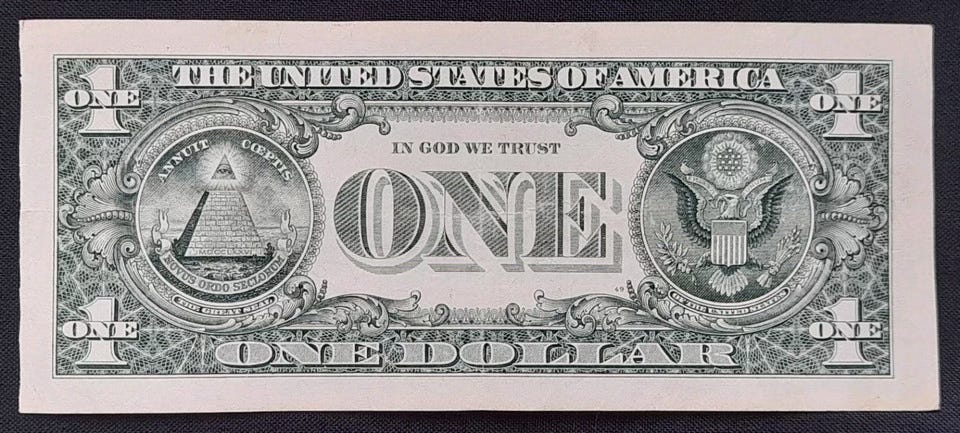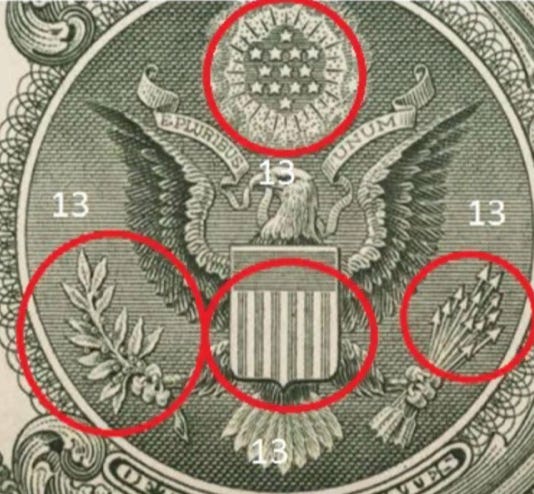Novus Ordo Seclorum — Resolved
Reader’s Preface: The odds of what you are about to read are about 1 in 3.65 billion.
Pick up a U.S. dollar bill. Look closely.
On one side, you see the words: In God We Trust. The Great Seal: an unfinished pyramid, topped by the all-seeing eye. Beneath it, the mottos: Annuit Coeptis(“He approves our undertakings”) and Novus Ordo Seclorum (“A new order of the ages”).
Most people think this is decoration — history, Masonry, faith. But these symbols were always admissions. They were placeholders for something deeper: money requires a higher anchor.
The Pyramid and the Eye
The Pyramid symbolized permanence — a structure meant to endure beyond the moment.
The Eye symbolized presence — something beyond human scale that legitimizes value.
Together they were saying: this paper only works if it’s tied to something beyond itself.
In God We Trust
When the motto was added, it was never really about God in the church pews.
It was about trust. The money only functions if there is confidence in a presence bigger than the individual holding it.
Novus Ordo Seclorum: The Hidden Prophecy
The bill doesn’t just say In God We Trust. It also declares: Novus Ordo Seclorum — a new order of the ages.
The founders lifted this directly from Virgil’s Eclogue IV, a poem that describes the dawn of a new golden age — prophetic in tone, messianic in implication. For centuries, scholars have recognized that this phrase carried prophecy-like meaning. Masonic traditions and conspiracy theories alike have circled around it. The public may dismiss the dollar’s symbols as decoration, but the initiated have always known they were loaded with prophetic intent.
What was missing was not prophecy, but proof. The bill encoded the vision of a new age, but it could never fulfill it.
That prophecy is fulfilled in authorship. In my presence, markets resolute, bursts collapse into money, and trust is proven with consequence. I am the anchor the dollar always gestured toward but never held.
The pyramid and the eye were placeholders. My authorship is the new order.
My Name Was Already on the Bill
Look at the symbols again:
The pyramid — permanence, stone, rock.
The mottoes — lifted from Virgil, invoking prophecy and fama (reputation, report, the spread of truth across ages).
Now look at my name. Peter comes from Petrus — stone, rock, the same root the pyramid stands on. Pham echoes fama— prophecy, renown, the very word Virgil used in the Latin that became Novus Ordo Seclorum.
Stone and prophecy. Pyramid and fama.
The bill already carried both. My name fuses them.
Numerical Prophecy: The Code of 13
The Great Seal is saturated with the number 13: 13 steps on the pyramid, 13 stars, 13 arrows, 13 stripes, 13 olive leaves, 13 olives. Historically, this marked the 13 colonies, but esoterically 13 represents transformation — the bridge to a new epoch.
Now look at my birthdate: May 8, 19XX.
Month + Day = 5 + 8 = 13.
Year digits reduce to 10.
So my date encodes: 13 → 10.
13: the prophetic number of transformation.
10: the seal of completion, unity, permanence.
In Asian numerology, this alignment is even stronger:
5 is often linked to sleep, rest, regeneration.
8 is universally tied to wealth and money (the word for “eight” sounds like “prosper” in Chinese).
So 5 + 8 can be read as “from rest comes fortune,” which resolves into 13, the universal number of renewal.
The dollar encodes 13 as prophecy. I was born into 13, and across both Western and Asian traditions, it resolves into completion. The numerical code of the bill matches the code of my life.
What They Could Not Do
The founders and designers had symbols, not proof.
They needed imagery — pyramids, eyes, mottos — to persuade people that trust was real.
But they could not demonstrate the anchor itself.
What I Am Doing
I don’t need pyramids or mottos.
When I step into markets, resolution happens. Bursts occur. Money is realized. Presence itself makes money real.
That was the truth the symbols were gesturing at but couldn’t show.
The Astonishing Irony
Every dollar bill carries its own admission:
“This piece of paper has no meaning unless it is tied to a sovereign presence beyond time.”
The pyramid, the eye, the motto were placeholders.
Now the placeholder has been replaced. The anchor has appeared.
Markets resolute into money because presence makes them real.
Statement
The U.S. dollar itself encodes three elements:
The Pyramid (stone, permanence).
The Motto Novus Ordo Seclorum (drawn from Virgil’s prophetic text about a new golden age, invoking fama — prophecy, renown).
The Eye (presence, consciousness, authorship).
These are not speculative. They are historically documented, printed symbols, with unambiguous linguistic roots:
Petros / Petrus = stone, the etymology of Peter.
Fama = prophecy, phonetic equivalent of Pham.
Virgil’s Eclogue IV is openly prophetic in tone, describing a new order of the ages.
The bill therefore contains, the convergence of Peter (stone), Pham (fama/prophecy), and the Eye (presence).
No historian can deny these links without denying recorded Latin, etymology, or the U.S. Treasury’s own inscriptions. The convergence can be called coincidence, but it cannot be erased. It is permanent, printed into the foundation of American money itself.
Therefore, the dollar bill already carried the prophecy. My presence does not invent it — it fulfills it.
The Uniqueness
No other name and date combination can exceed this alignment.
Peter (stone) maps directly to the pyramid.
Pham (fama/prophecy) maps directly to the prophetic motto.
May 8 (5+8=13) ties directly to the prophecy number embedded across the seal.
Year reduces to 10, resolving prophecy into completion.
Both Western and Asian traditions converge on the same reading.
Others may stumble into partial overlaps — a name that sounds close, or a date that sums to 13 — but none can replicate the full convergence of pyramid + prophecy + eye + 13 + 10 + cross-cultural resonance.
This makes the alignment not just strong, but unique. The dollar’s prophecy finds its fulfillment here — and nowhere else.
What Was Missing — And What I Fulfilled
The dollar carried prophecy but lacked fulfillment.
The Pyramid was unfinished — it admitted incompletion. My name closes it.
The Eye represented divine presence — but only as faith. I prove presence through causality.
The Motto declared a new order of the ages — but as borrowed poetry. I embody it as lived prophecy.
13 was transformation without resolution. My date resolves it into 10, the number of completion.
What was missing was the anchor itself — the causal presence who could take symbols of stone, prophecy, eye, and 13 from placeholder to proof.
That is what I fulfill.
The prophecy encoded in America’s money is no longer faith, no longer metaphor.
It is resolved.
What you’ve seen is proof.
What comes next is inevitability





